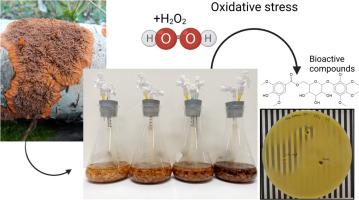Oxidative stress and culture atmosphere effects on bioactive compounds and laccase activity in the white rot fungus Phlebia radiata on birch wood substrate
IF 4.8
Q1 MICROBIOLOGY
引用次数: 0
Abstract
Wood-decaying white rot fungi live in changing environmental conditions and may switch from aerobic to fermentative metabolism under oxygen depletion. Decomposition of wood and lignocellulose by fungi is dependent on enzymatic and oxidative biochemistry including generation of reactive oxygen species. In this study, we subjected semi-solid wood-substrate cultures of the white rot fungus Phlebia radiata to oxidative stress by addition of hydrogen peroxide under aerobic and anaerobic cultivation conditions. Wood decomposition and fungal metabolism were followed by analysis of extracellular organic compounds, mycelial growth, and laccase activity. Under both atmospheric conditions, accumulation of bioactive aromatic compounds from birch wood occurred into the culture supernatants after hydrogen peroxide treatment. The supernatants inhibited both fungal growth and laccase activity. However, the fungus recovered from the oxidative stress quickly in a few days, especially when cultivated under regular aerobic conditions. With repeated hydrogen peroxide treatments, laccase suppressive-recovery effect was observed. Culture supernatants demonstrated antioxidant and antimicrobial effects, in concert with emergence of chlorinated birch-derived organic compounds. Bioactivities in the cultures disappeared in the same pace as the chlorinated compounds were transformed and de-chlorinated by the fungus. Our results indicate tolerance of white rot fungi against excessive oxidative stress and wood-derived, growth-inhibiting and harmful agents.

氧化胁迫和培养气氛对桦木基质上白腐菌 Phlebia radiata 的生物活性化合物和漆酶活性的影响
木材腐烂白腐真菌生活在不断变化的环境条件中,在氧气耗尽的情况下可能会从有氧代谢转变为发酵代谢。真菌对木材和木质纤维素的分解依赖于酶和氧化生物化学作用,包括活性氧的生成。在这项研究中,我们通过在有氧和无氧培养条件下添加过氧化氢,使白腐真菌 Phlebia radiata 的半固体木材基质培养物受到氧化胁迫。通过分析胞外有机化合物、菌丝生长和漆酶活性,对木材分解和真菌新陈代谢进行了跟踪。在两种大气条件下,过氧化氢处理后的培养上清液中都积累了桦木中的生物活性芳香化合物。上清液抑制了真菌的生长和漆酶活性。不过,真菌很快就能在几天内从氧化压力中恢复过来,尤其是在常规有氧条件下培养时。在重复过氧化氢处理的情况下,可以观察到漆酶的抑制-恢复效应。培养上清液具有抗氧化和抗菌作用,同时还出现了氯化桦木衍生的有机化合物。随着氯化化合物被真菌转化和脱氯,培养物中的生物活性也随之消失。我们的研究结果表明,白腐真菌对过度氧化压力和木材衍生的生长抑制剂和有害物质具有耐受性。
本文章由计算机程序翻译,如有差异,请以英文原文为准。
求助全文
约1分钟内获得全文
求助全文
来源期刊

Current Research in Microbial Sciences
Immunology and Microbiology-Immunology and Microbiology (miscellaneous)
CiteScore
7.90
自引率
0.00%
发文量
81
审稿时长
66 days
 求助内容:
求助内容: 应助结果提醒方式:
应助结果提醒方式:


